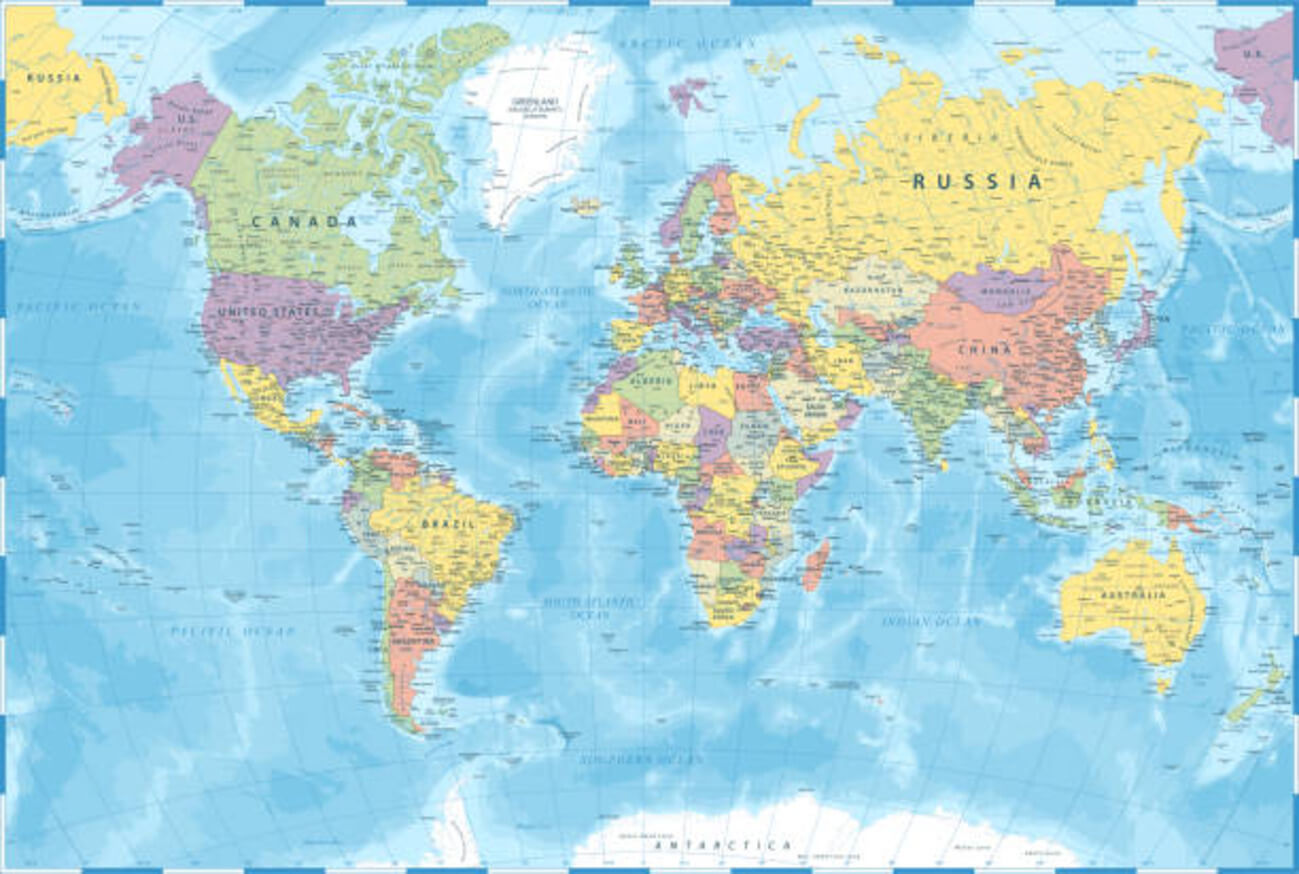The Largest Countries in the World
With seven billion people living on Earth, how do we know which countries are the biggest? To answer this question, we need to look at population, geographical area, and other factors.
This article will take a look at the largest countries in the world by landmass and population so that you can get an idea of just how big these places are. We will also explore some fun facts about each country to give you an even better understanding of their size and importance. Get ready to be amazed!
Also, check out The Best Gaming Laptops.
Advertisement
Largest Countries in the World
Listed below are some of the largest countries in the world:
Russia
Russia is the largest country in the world, with a land area of over 17 million square kilometers. It is located in Eastern Europe and Northern Asia and shares borders with fourteen other countries.
The population of Russia is over 143 million people, making it the ninth most populous country in the world. The capital of Russia is Moscow, and the official language is Russian.
Russia has a long history dating back to the ninth century when it was first settled by Slavic tribes. In the thirteenth century, Moscow became the capital of an emerging Russian state.
Since then, Russia has gone through many changes, including periods of expansion and conquest, as well as periods of decline and political turmoil. Today, Russia is a federal semi-presidential republic.
The economy of Russia is the sixth largest in the world in terms of nominal GDP and is also one of the fastest-growing economies.
Oil and natural gas are major exports for Russia, and it also has a large agricultural sector. Tourism is another important industry in Russia, with visitors attracted to its many historic sites and cultural attractions.
Canada
Canada is the second largest country in the world, covering an area of 10 million square kilometers. Canada has a population of over 36 million people, and its capital city is Ottawa.
Canada is a federal parliamentary democracy and a constitutional monarchy, with Queen Elizabeth II as its head of state. The country is divided into ten provinces and three territories, with each province having its own elected legislature and government.
Canada is a developed country and has a high standard of living. It is a member of the United Nations, the G8, and the Organization for Economic Cooperation and Development (OECD).
The economy of Canada is diversified, with sectors such as agriculture, forestry, fishing, mining, manufacturing, energy, finance, and service all contributing to the country’s GDP. Canada is one of the world’s leading trading nations and has a strong relationship with the United States, its southern neighbor.
Advertisement
United States
The United States is the third largest country in the world with a population of 327,167,434. It covers a total area of 9,826,675 square kilometers. The United States has a diverse landscape and climate, ranging from the tropical islands of Hawaii to the arctic tundra of Alaska.
The United States is a federal republic made up of 50 states and a federal district. Washington D.C., the capital of the United States, is located on the East Coast between Virginia and Maryland. The United States has two official languages: English and Spanish.
The economy of United States is the world’s largest national economy with a GDP of $19.39 trillion dollars as of 2020. The United States is also home to some of the world’s largest companies such as Walmart, Apple Inc., Amazon, and ExxonMobil.
The United States is a major tourist destination with over 75 million foreign visitors each year. Some of the most popular tourist destinations in the United States include New York City, Orlando, Las Vegas, and San Francisco.
China
As the world’s most populous country, China is home to over 1.4 billion people – that’s nearly one in every five people on earth! Covering a vast land area of 9.6 million square kilometers, it’s no wonder that China is the world’s third-largest country by landmass.
China has a long and rich history, dating back thousands of years. It was once an imperial power, ruled by powerful dynasties such as the Ming and Qing. Today, it is a communist state, governed by the Chinese Communist Party.
Despite its large size and population, China is relatively young as a country – it only became a unified nation in 221 BCE under the first emperor, Qin Shi Huangdi. Since then, China has undergone many changes, including periods of turmoil and upheaval.
Today, China is one of the world’s leading economic powers. It has the second-largest economy in the world (after the United States) and is continuing to grow at a rapid pace. In recent years, China has also become increasingly active on the global stage, asserting itself as a major player in international affairs.
Also, check out The Richest Banks in Nigeria.
Brazil
Brazil is the fifth largest country in the world, with a population of over 200 million people. It covers an area of over 3 million square miles, making it the largest country in South America. Brazil has a diverse landscape, with forests, mountains, and beaches.
Its capital, Brasília, is one of the most modern cities in the world. Brazil is known for its music and dance, as well as its food and coffee.
Australia
Australia is the world’s smallest continent and sixth largest country, with a land area of 7,692,024 square kilometers. The population of Australia is 24,773,000 as of 2019. The capital city of Australia is Canberra and the most populous city is Sydney.
Australia is a constitutional monarchy with a parliamentary democracy. The Queen of Australia is Elizabeth II, who is also the Queen of the United Kingdom and the other Commonwealth realms. The Head of Government is the Prime Minister of Australia.
The economy of Australia is a developed market economy with a GDP of $1.89 trillion as of 2019. The country has abundant natural resources, including iron ore, coal, gas, oil, gold, nickel, uranium, and copper. Agriculture and tourism are also important industries in Australia.
India
India is the world’s second most populous country with over 1.3 billion people, and it is projected to be the world’s most populous country by 2027. India is a diverse country with a rich history and culture.
It is home to some of the world’s oldest civilizations, including the Indus Valley Civilization and the Vedic Civilization. India is a democratic republic with a parliamentary system of government. The official languages of India are Hindi and English, and there are 22 recognized languages in India.
India is one of the largest countries in the world, with an area of 3,287,590 square kilometers (1,269,346 square miles). India’s coastline stretches for 7,517 kilometers (4,671 miles), and it shares land borders with Pakistan to the west, China and Nepal to the north, Bhutan to the northeast, and Bangladesh and Myanmar to the east. India also has maritime borders with Sri Lanka and Maldives to the south and Indonesia to the southeast.
Argentina
Argentina is the second largest country in South America, after Brazil. It covers an area of 2,780,400 square kilometers (1,073,500 square miles), making it slightly smaller than the state of Texas in the United States.
Argentina has a population of 44,271,351 people, which makes it the 32nd most populous country in the world. The capital and largest city are Buenos Aires.
Spanish is the official language of Argentina, although it is not the only language spoken there. Other languages spoken in Argentina include Quechua, Guarani, and English. Spanish is also widely spoken in neighboring countries such as Uruguay and Chile.
Argentina has a diverse landscape that includes everything from glaciers and deserts to rainforests and grasslands. The Andes mountain range runs through western Argentina and contains some of the highest peaks in all of South America.
Mount Aconcagua, at 6962 meters (22,841 feet), is the tallest mountain in both Argentina and all of South America.
The climate in Argentina varies depending on location. The northern part of the country has a subtropical climate while the southern parts experience cooler climates with more precipitation. Buenos Aires has a temperate climate with four distinct seasons.
Argentina is home to a variety of wildlife including llamas, alpacas, guanacos (a relative of the llama), jaguars, pumas
Kazakhstan
Kazakhstan is the world’s largest landlocked country, and it is also the ninth-largest country in the world by area. The country covers an area of 2,724,900 square kilometers, making it about four times the size of Texas.
Kazakhstan is located in Central Asia and borders Russia, China, Kyrgyzstan, Uzbekistan, and Turkmenistan. The capital city of Kazakhstan is Astana.
Kazakhstan has a varied climate due to its large size. The southern part of the country experiences hot summers and mild winters, while the northern part of the country experiences cold winters with heavy snowfall.
The economy of Kazakhstan is based on agriculture and mining. The country is rich in mineral resources, such as oil, gas, coal, uranium, and zinc. Kazakhstani exports include petroleum products, metals, grain, wool, and livestock.
The population of Kazakhstan was 18,556,185 as of July 2016. The majority of the population is ethnic Kazakh (63%), followed by Russians (23%), Uzbeks (2%), Ukrainians (1%), Germans (1%), Tatars (1%), and other ethnicities (8%). Islam is the largest religion in Kazakhstan (70%), followed by Christianity (26%).
Final Notes on The Largest Countries in the World
There are a number of factors that can contribute to the size of a country. One factor is the geographical location of the country. Countries that are located in regions with large land masses, such as Russia and Canada, are likely to be larger than countries located on smaller land masses, such as island nations.
Historical factors can also play a role in the size of a country. For example, a country that has expanded through conquest and colonization is likely to be larger than a country that has not.
Political factors, such as the desire to gain access to resources or to increase the country’s influence and power, can also contribute to the size of a country. In some cases, countries have expanded their borders through the use of military force, while in other cases, they have done so through negotiation and diplomacy.
Finally, physical features such as mountains, rivers, and deserts can also influence the size of a country. For example, a country with a long coastline is likely to be larger than a country with a shorter coastline, as it will have more access to the ocean and the resources it provides.
Before you go, check out the Most Expensive Phones in the World.







One Comment
Comments are closed.